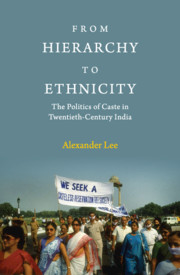Book contents
- Frontmatter
- Dedication
- Contents
- List of Tables
- List of Figures
- Acknowledgements
- 1 Introduction
- 2 Explaining Identity Activism
- 3 Caste in Historical Context
- 4 Caste in the Census of India
- 5 The Causes of Ranked Rhetoric
- 6 Caste since Independence
- 7 Conclusion
- Appendix A Data
- Appendix B Statisical Tests
- Appendix C Additional Tables and Figures
- Bibliography
- Index
4 - Caste in the Census of India
Published online by Cambridge University Press: 14 January 2020
- Frontmatter
- Dedication
- Contents
- List of Tables
- List of Figures
- Acknowledgements
- 1 Introduction
- 2 Explaining Identity Activism
- 3 Caste in Historical Context
- 4 Caste in the Census of India
- 5 The Causes of Ranked Rhetoric
- 6 Caste since Independence
- 7 Conclusion
- Appendix A Data
- Appendix B Statisical Tests
- Appendix C Additional Tables and Figures
- Bibliography
- Index
Summary
Much of the activity of ethnic activists, in particular their social and educational activities, occurred in a private, vernacular language world that was difficult for outsiders to observe even at the time. Variation in the level of importance attached to social ranking is similarly difficult to measure in practice, since much of the expression of ranking norms is cultural and takes place outside formal state structures. The role of the census in colonial India provides an interesting exception to this pattern: quite unintentionally, the colonial state created a means by which caste activists could register their activities and aspirations, and a language in which those aspirations could be expressed.
The census assumed the role of a forum for caste claims when superintendent H. H. Risley decided to organize the census returns by hierarchical caste status. While Risley's goal was to generate data supporting his own theory of the racial origins of caste, the classification change had dramatic consequences: many lower and middle caste elites anxious to maximize their hierarchical status organized to petition the census authorities for a new caste name, typically one that linked them to a ‘higher’ caste or to one of the three higher varnas of the Sanskritic caste hierarchy. Other caste elites also petitioned for new names, to distance themselves from the ranking system entirely, by disassociating themselves from names that suggested subordination.
The census, of course, was not a neutral participant in this process. Simply by asking Indians about their caste, the census authorities potentially made caste more salient to individuals than it had been previously. Moreover, the census's simple categories (and in some periods interest in a single hierarchical dimension) tended to delegitimize and override previous, perhaps more ambiguous, identities (Dirks 2002). However, as we shall see, there was considerable variation in the way in which caste activists used these new concepts and categories.
Caste in the census
While statistical enumerations of India had long collected information about caste (Guha 2003), the connection between caste and the census changed in the early twentieth century through the work of H. H. Risley, who became superintendent of the Census of India for the 1901 census.
- Type
- Chapter
- Information
- From Hierarchy to EthnicityThe Politics of Caste in Twentieth-Century India, pp. 83 - 110Publisher: Cambridge University PressPrint publication year: 2020



